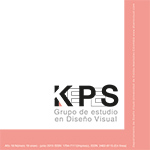Authors
Abstract
The current condition of interactive museums requires that they allow knowledge of science to be transmitted through the relationship of the subject with the exhibition. An example on this subject is found in the interactive Mind, the world inside room at Parque Explora (Medellín, Colombia), a space divided into six sections that offers the visitor an experience about how the brain works. Taking this place as an object of study, the research that was carried out was aimed at identifying which concept of body is created around the interaction and communicative interactivity that the room provides the visitor with. For this purpose, the case study, ethnography (under the modalities of direct source and participant observer) methods, the documentary analysis of contents and objects of the room were used, together with the application of the experimental method and the mapping of the route of the users. This methodological wrap produced as a result that the design elements that communicate in the room do not comply with their interactive functionality and that the behavior of the visitors in the room is conditioned by the presence of the "mediator", which is not the purpose of the environment. Both findings show that the Mind, the world inside room at Parque Explora, does not comply with the dynamics proposed by interactive museums, whose purpose is to communicate science and technology through their objects.
Keywords:
References
Almengual, G. (2007). El concepto de experiencia: de Kant a Hegel. Tópicos (15). Recuperado de: http://www.scielo.org.ar/scielo.php?script=sci_arttext&pid=S1666-485X2007000100001#ref
Alsina, M.R. (2001). Capítulo III: las perspectivas de la teoría de la comunicación. Teorías de la comunicación: ámbitos, métodos y perspectivas (pp. 161-04). Barcelona: Aldea Global.
Briceño, J.J. y Tafur, S.M. (2011). Caracterización del diálogo guía-estudiante en un Museo Interactivo de Ciencia y Tecnología de Bogotá (Colombia). Revista Electrónica de Enseñanza de las Ciencias, 10 (2), 289-305.
Cerda, H. (1993). Los elementos de la investigación, como reconocerlos, diseñarlos y construirlos. Quito, Ecuador: Abya Yala.
Cisneros, A. (1999). Interaccionismo simbólico, un pragmatismo acrítico en el terreno de los movimientos sociales. Sociológica, 14 (41), 104-126.
Díaz, C.L. (2003). El cuerpo, ese objeto marcado por el exceso del otro. Desde el Jardín de Freud, 3, 98-105.
Gutwill, J., Hido, N. and Sindorf, L. (2015). Research to Practice: Observing Learning in Tinkering Activities. The Museum Journal, 58 (2), 151-168.
Jaramillo A. M. (2012). Lo que dice el silencio: dilemas museológicos en la exposición Mente, el mundo adentro. Uni.pluri/versidad, 12 (3), 88-96. Recuperado de https://aprendeenlinea.udea.edu.co/revistas/index.php/unip/article/view/15356/0
Jiménez, S. y Palacio, M. (2010). Comunicación de la ciencia y la tecnología en museos y centros interactivos de la ciudad de Medellín. Universitas Humanística, 69, 227-257.
Meritxell, E. (2002). Revista Latinoamericana de Tecnología Educativa, 1 (1), 22.32. Interactividad e interacción. Recuperado de http://relatec.unex.es/article/view/2
Moreno, I. (2015). Interactividad, interacción y accesibilidad en el museo transmedia. ZER-Revista de Estudios de Comunicación, 20 (38), 87-107.
Moles, A. (1974). Teoría de los objetos. Barcelona, España: Gustavo Gili.
Molina, N. (2005) El cuerpo: museo y significado controlado. POLIS. Revista Latinoamericana, 11. Recuperado de http://polis.revues.org/5746.
Muñoz, H. (2014). Factores de diseño que determinan la interacción y la experiencia estética en exposiciones interactivas sobre ciencia. Revista KEPES, 11 (10), 209-225.
Norman, D. (1990). Psicología de los objetos cotidianos. Madrid, España: Nerea S.A.
Parque Explora. (Sin fecha). ¿Qué es el Parque Explora? Recuperado de http://reservas.parqueexplora.org/quienes-somos/direccionamiento/-que-es-elparque-explora-/.
Pons, X. (2010). La aportación a la psicología social del interaccionismo simbólico: una revisión histórica. EduPsykhé: Revista de Psicología y Psicopedagogía, 9 (1), 23-41.
Rizo, M. (2004). El interaccionismo simbólico y la Escuela de Palo Alto. Hacia un nuevo concepto de comunicación. Recuperado de http://portalcomunicacion.com/lecciones_det.asp?lng=esp&id=17
Yacuzzi, E. (2005). El estudio de caso como metodología de investigación: teoría, mecanismos causales, validación. Universidad del CEMA.
Zangara, A. y Sáenz, C. (2012). Aproximaciones al concepto de interactividad educativa. SEDICI. Recuperado de http://sedici.unlp.edu.ar/handle/10915/25943.

 pdf (Español (España))
pdf (Español (España))
 FLIP
FLIP
 Perfil Google Scholar
Perfil Google Scholar


















